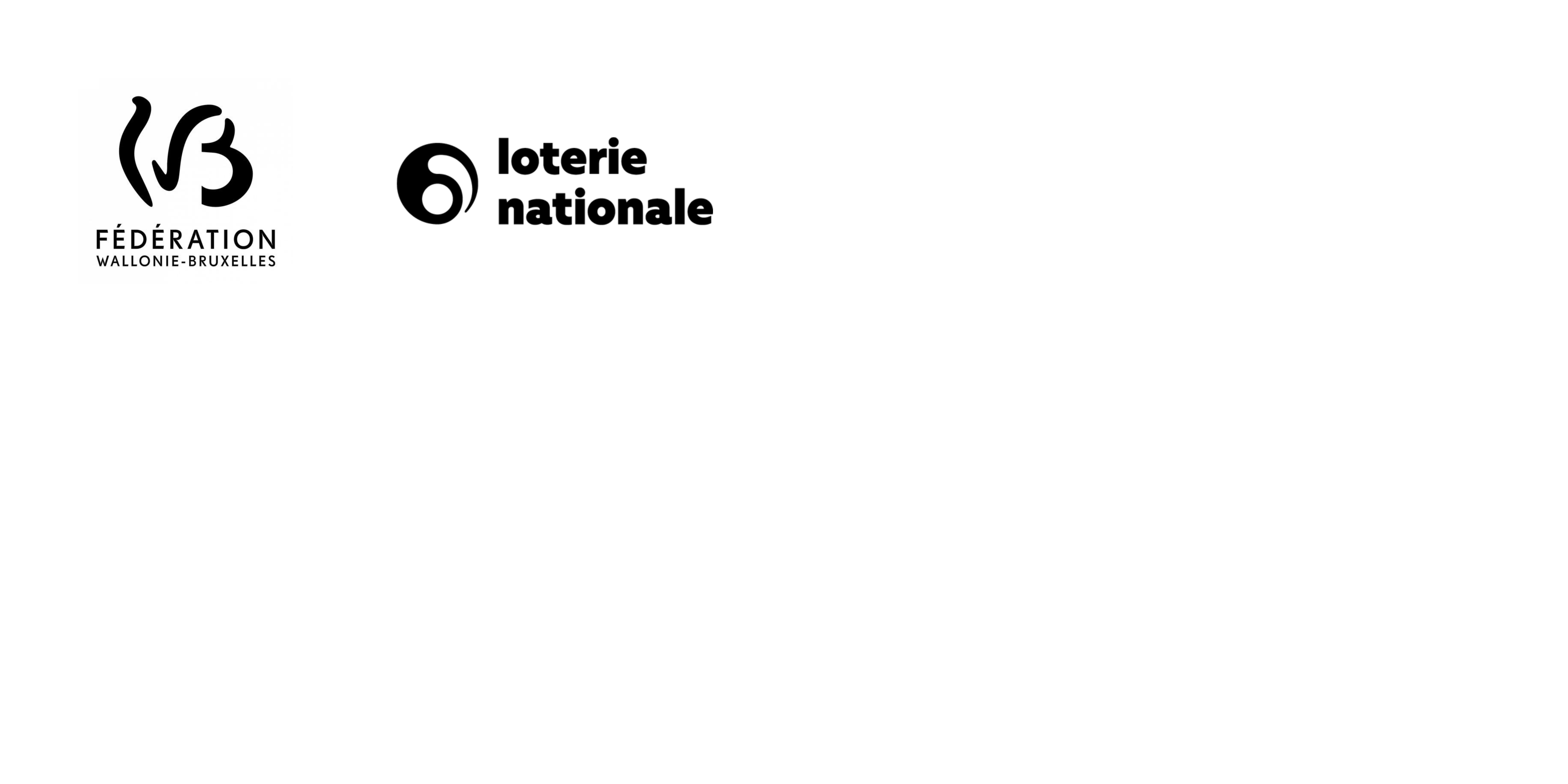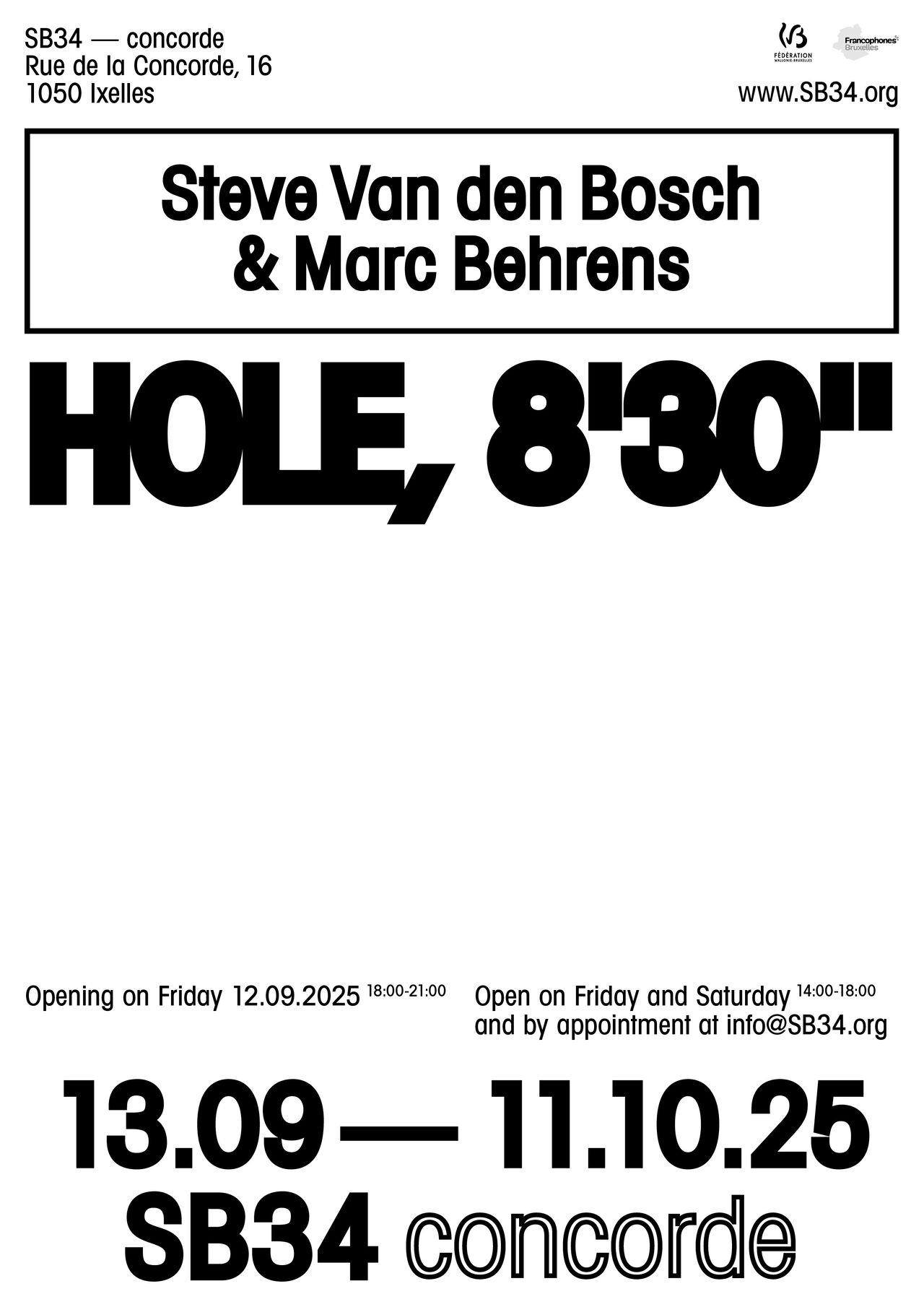

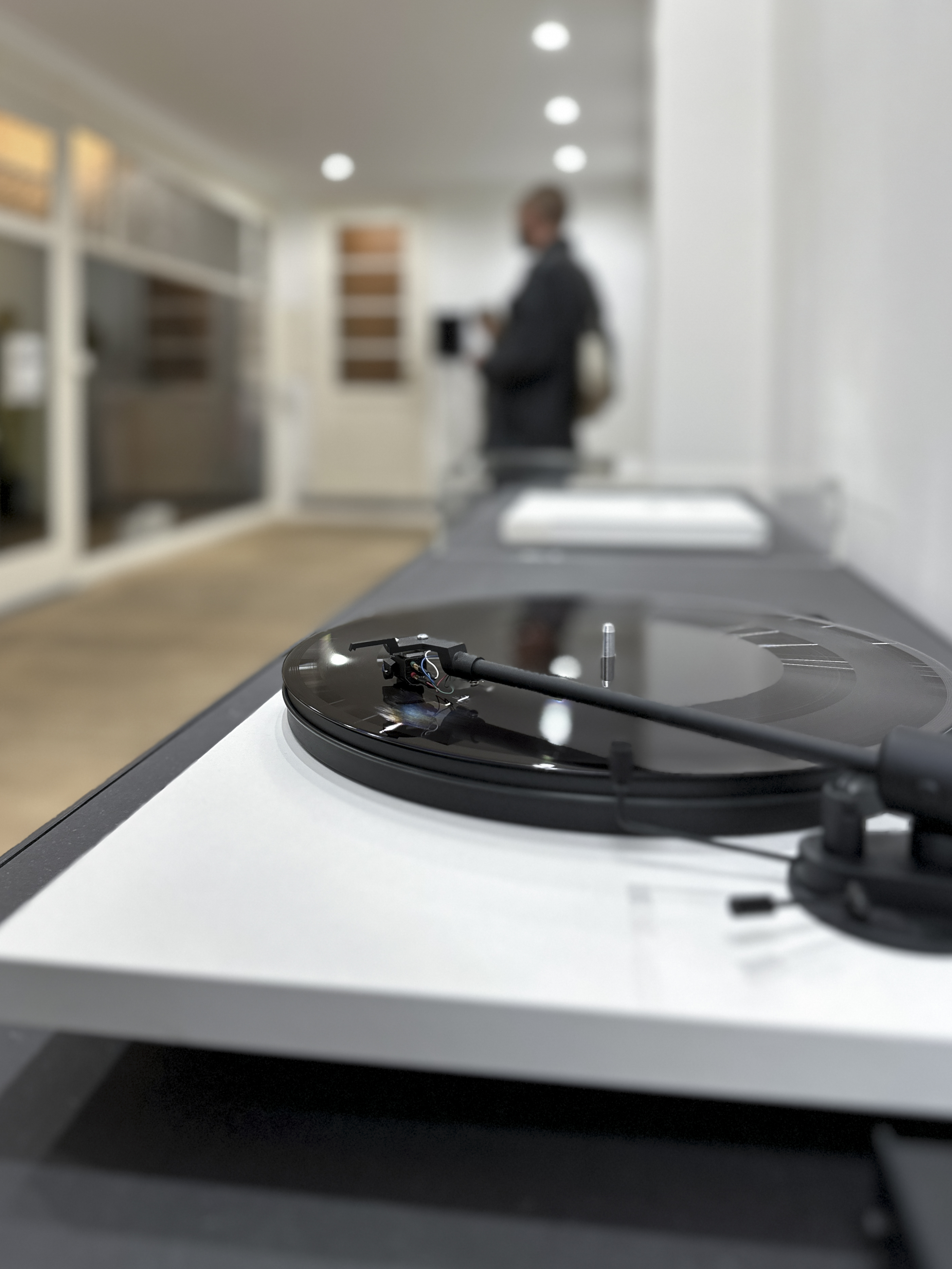


︎ SB34 concorde
HOLE, 8'30"
Steve Van den Bosch & Marc Behrens
13.9 - 11.10.2025
Hole, 8'30" features a collaborative work that consists of a sonic reinterpretation by Marc Behrens of a previous work by Steve Van den Bosch, engraved on an aluminum lacquer disc. Exhibited at SB34 concorde for the first time, the piece activates the acoustic properties of the exhibition space, while its repeated playing will eventually erase the recording from its carrier. By linking the echoes and frequencies of language to the structure of the exhibition space, the installation questions the conditions of disappearance, testimony, and trace.
︎ CONTEXT
Hole
2006
Recording on MiniDV cassette, wall
Dimensions variable
A hole is made in the wall that divides one room from another. The making of the hole is recorded on MiniDV until the opening is big enough to see the adjacent space and to fit the MiniDV cassette. At this point the cassette is taken out of the camera without re-winding it and put into the hole after which the wall is carefully restored into its original state.
2018
One-sided 12 inch aluminium lacquer disc
8 min 30 sec
Composition Marc Behrens
Voice Kate Mayne
Concept Steve Van den Bosch and Marc Behrens
Hole 2006 Steve Van den Bosch
Cut Schallplatten Schneid Technik GmbH
Archival package Lindauer GmbH & Co. KG
Silkscreen Afreux
Ed. / 10
+ 2 AE
︎ TEXT BY PAULINE HATZIGEORGIOU
De quoi parle-t-on lorsqu’on parle d’extractivisme ? De ce que l’on prélève pour le déplacer ailleurs, où il prendra de la valeur. Mais si on l’extrait, c’est parce qu’il porte déjà en lui cette valeur. Cette boucle trouve son écho dans le discours sur l’art : ce qui est montré dans l’exposition ferait presque figure d’alibi, tant une part de l’œuvre – sa condition de possibilité – se joue ailleurs, dans un champ d’anticipation et de projection. Et dans ce jugement porté sur elle, c’est toujours un peu de soi qui s’inscrit.
On pourrait voir, dans le déplacement de l’aiguille effleurant les sillons du disque – qui tire, rabat la périphérie vers le centre, ramène la marge au milieu – un mouvement de rembobinage de la circulation de la valeur. Toute dualité contient d’ailleurs déjà son contraire : la gauche est comprise dans la droite, la droite englobe la gauche. David Graeber éclaire cette asymétrie : la valeur n’est jamais close sur elle-même, elle est façonnée depuis l’extérieur1.
Ainsi, lorsqu’une institution – en l’occurrence, un programme de résidence – demande à Steve Van den Bosch de lui céder une œuvre en contrepartie implicite de sa participation, elle révèle que son désir précède l’échange. Van den Bosch répond par la pièce Hole (2006): percement du mur, enregistrement de l’action dans une vidéo, emmurement de la bande, rebouchage du trou, production d’une attestation. Soit une procédure inframince, « la trace (consignée) d’une disparition ». Une dizaine d’années plus tard, dans le cadre d’une exposition solo à Garage Mechelen, il commissionne à Marc Behrens une pièce sonore, une List of works (2016), qui remplaçait le texte imprimé par une version audio à 4 canaux devenant peu à peu psychotique à mesure qu’elle se désintégrait. Cette économie d’estime se prolongera à nouveau quelques années plus tard, dans une collaboration entre les deux artistes. En résulte cette composition sonore, Hole (2018): une interprétation acoustique de l’œuvre précédente, basée sur l’enregistrement de sa légende parlée, qui ne figurait pas dans List of works. On glisse alors de « la trace (consignée) d’une disparition » vers la « fabrication d’une mémoire factice ». La piste est gravée sur un disque (en dix tirages) en aluminium laqué, support promis à l’usure par le passage, répété, de l’aiguille. La pièce, exposée ici pour la première fois, creuse un manque, l’effet de paranoïa servant de paramètre de production au sein d’une réverbération spatiale.
En pensant à ce disque, m’est venue l’image de l’artiste en monnayeur : mythe créatif de l’œuvre produite ex nihilo, fantasme persistant d’un atelier où se « frappe » la valeur qui circulera par la suite.
Or, chez Graeber, la monnaie et l’objet de valeur ne relèvent pas du même régime : la première efface ses conditions d’émission pour se présenter comme équivalence universelle, tournée vers l’avenir, vers ce qu’on pourrait en faire ; le second conserve en lui la mémoire des attachements passés. A l’évidence, l’œuvre d’art complexifie largement cette distinction. Ce disque, témoignerait-il d’une forme de compression ?
Il se fait que les récits autour des désirs de désaliénation de l’art intègrent souvent une part d’inutilité ou le refus d’adhérer aux logiques marchandes. Mais ce refus reste paradoxalement lié à ces mêmes logiques (les pièces qui se prétendent « hors circuit » paraissent d’ailleurs souvent plus facilement bancables). Ce disque relaie ses antécédents, tant dans ses étapes de production par délégation que
dans ses légitimations, devenant autant de matérialisations d’une dette. Pensons d’ailleurs au terme « usure », à double face. Longtemps, son sens premier renvoyait au profit tiré du crédit et des intérêts tandis que l’idée d’une matière qui s’abîme par le temps et l’usage n’était qu’un dérivé. Aujourd’hui, dans un régime financiarisé où la moralité de l’intérêt est rarement interrogée, ce premier sens s’est effacé au profit du second. Mais on s’égare.
Hole, 8’30’’ se déploie donc dans un champ de contamination. Elle pointe vers cette utilité marchande tout en se prémunissant de son propre risque d’inutilité. En remontant sa généalogie, ses réseaux institutionnels, son tissu d’attaches, etc., en bref, en déployant sa perspective contextuelle, l’œuvre assume sa part d’impropre. L’institution, par son invitation et son anticipation, a toujours un coup d’avance : ce qui est présenté existe déjà ailleurs. L’exposition ne fait que rembobiner cette procédure, matérialisant un mouvement rotatif où la valeur circule, s’extrait et se redépose.
Pauline Hatzigeorgiou
1 : David Graeber, La fausse monnaie de nos rêves. Vers une théorie anthropologique de la valeur Paris, Éd. Les Liens qui libèrent, 2022
︎ TEXT BY ALICJA MELZACKA
[This text was performed by Francesca Hawker on 11.10.2025 at SB34 concorde]
A-ha!
What of the work that is made visible slash constitutes itself exclusively through the exhibition’s textual infrastructure? The slash here marks two distinct ontologies, one where the work is ‘made visible’ by infrastructural means—and, in what follows, must have already existed as a separate entity, and the other, where the work is ‘constituted through’ and indivisible from that infrastructure.
Say, ‘a hole is made in the wall that divides one room from another. The making of the hole is recorded on MiniDV until the opening is big enough to see the adjacent space and to fit the MiniDV cassette. At this point the cassette is taken out of the camera without re-winding it and put into the hole after which the wall is carefully restored into its original state.’
What remains? What remains is this caption. A ‘caption’—from Latin ‘captionem’, ‘to catch or to seize.’
Is a patched up hole still a hole? Is a patched up hole accompanied by the caption more of a hole? What happens if the caption is removed from the site of the original intervention? Does it point to THE hole or A hole? Does the caption document the disappeared hole, or does the hole continue staging its own disappearance through the caption?
Or—what of the work that is made visible slash constitutes itself through the REMOVAL of the exhibition’s infrastructure? Take Michael Asher’s intervention at Claire Copley Gallery in 1974, where the artist famously removed the key element of physical infrastructure—the wall that separated the exhibition space from the office. It was, in fact, a double removal, as the show involved no accompanying caption or other textual material. Even the artist’s original proposal had been delivered orally, as if to avoid leaving a trace. And yet, the intervention was eventually ‘captured’ by the critical discourse that followed. Infrastructure always finds a way to creep back in.
In most traditional cases, the caption points to the object and the object redirects to the caption—the work is held together by this internal self-referential dynamic. At the same time, this dynamic must be activated by the viewer. Art making us aware of our position as viewers represents a different kind of self-referentiality—an external one. And what better way to make the viewer aware of these ingrained dynamics than through removal? The kind where an object—say, a hole—is no longer present, yet the caption still gestures toward it. Or, conversely, when an object is there but lacks any textual infrastructure, and we tend to habitually look for one.
Self-referentiality relies on this ‘A-ha’ moment of breaking the illusion of unity, disrupting immersion. I can appreciate self-referential works, the way I can appreciate self-reflective people. The issue I’ve started to take with some works of that kind lately, though, is their hermetic dynamic: the work makes the viewer aware of the mechanisms of its production or display, of the viewer’s position, of the institutional framework in which in which this resides (or, it resides in us—in the end, ‘the the institution is inside of us’). But that’s where the circuit often closes.
After I have communed with the feeling that I know what a self-referential work wants me to know, that I have been MADE AWARE OF how it inscribes itself in the discourse of institutional critique, etc.; I like to ask then—what is left if self-referentiality is set aside? What escapes the capture of the mutually-legitimising bond between object and infrastructure, between work and viewer? What goes beyond the ‘becoming-aware’ kind of viewership?
I’ve been trying to think about examples of artistic strategies that don’t deflect self-referentiality but supercharge it—expanding its yield and potentially breaking open the hermetic circuit between the individual viewer and individual work. For instance, using the caption (from Hole, 2006) as a basis material for developing something else, say, a sound installation (also titled Hole, 2018). The caption functions both as a form of documentation, evidence, and as a score. Instead of closing the circuit, the work diverges to form an extension. Recursive self-referentiality as a generative strategy and a form of post-production.
Another work that comes to mind—though it operates on an entirely different basis—is Florence Jung’s Jung105 (2025), presented in a recent group show at Portikus in Frankfurt. It consisted of a caption, printed in the exhibition handout:
‘A rat was reportedly seen in the garden.’
One could argue there was a site-specific element to the work—it was marked on the floor plan next to a large window overlooking the backyard. You could stand there, scanning the greenery. But that’s not what interests me. I’m intrigued by the word ‘reportedly’ in the caption, doing some heavy lifting. The artist herself is not omniscient—she’s not DOCUMENTING an event, but rather, RECIRCULATING second-hand information, hearsay. This has less to do with dematerialisation and more with thinking about exhibitions in terms of time and labour rather than space and property.
Jung not only offers a commentary on the institutional authority, she also effectively undermines its hold. The work’s strength lies in its distribution model, which allows it to slip free of textual infrastructure and enter oral circulation and social exchange. Simply put: the work IS hearsay. And it continues circulating as hearsay, as my friends and I discuss it on our way back from the gallery. And now, you’ve also heard about the rat reportedly seen in the garden behind Portikus, sometime in 2025. Now, go tell someone. If you want. I mean, you don’t have to.
Alicja Melzacka
Interpreted and/or performed by Francesca Hawker
Interpreted and/or performed by Francesca Hawker
In conjunction with Hole, 8’30’’, an exhibition by Steve Van den Bosch and Marc Behrens at SB34 concorde, Brussels.
With unauthorised guest appearance of Florence Jung’s work produced for the show What Are You Thinking at Portikus, curated by Liberty Adrien & Carina Bukuts.
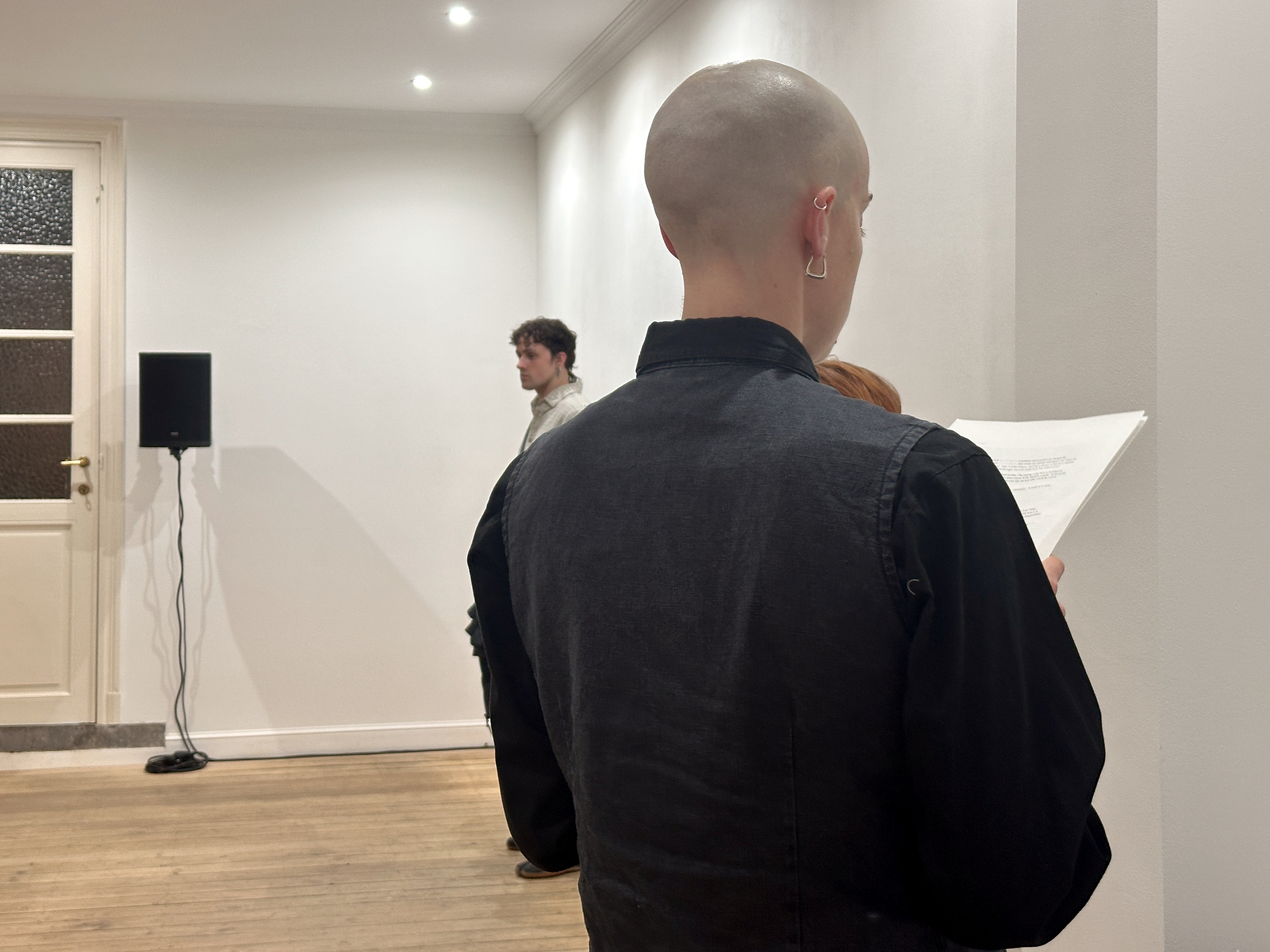
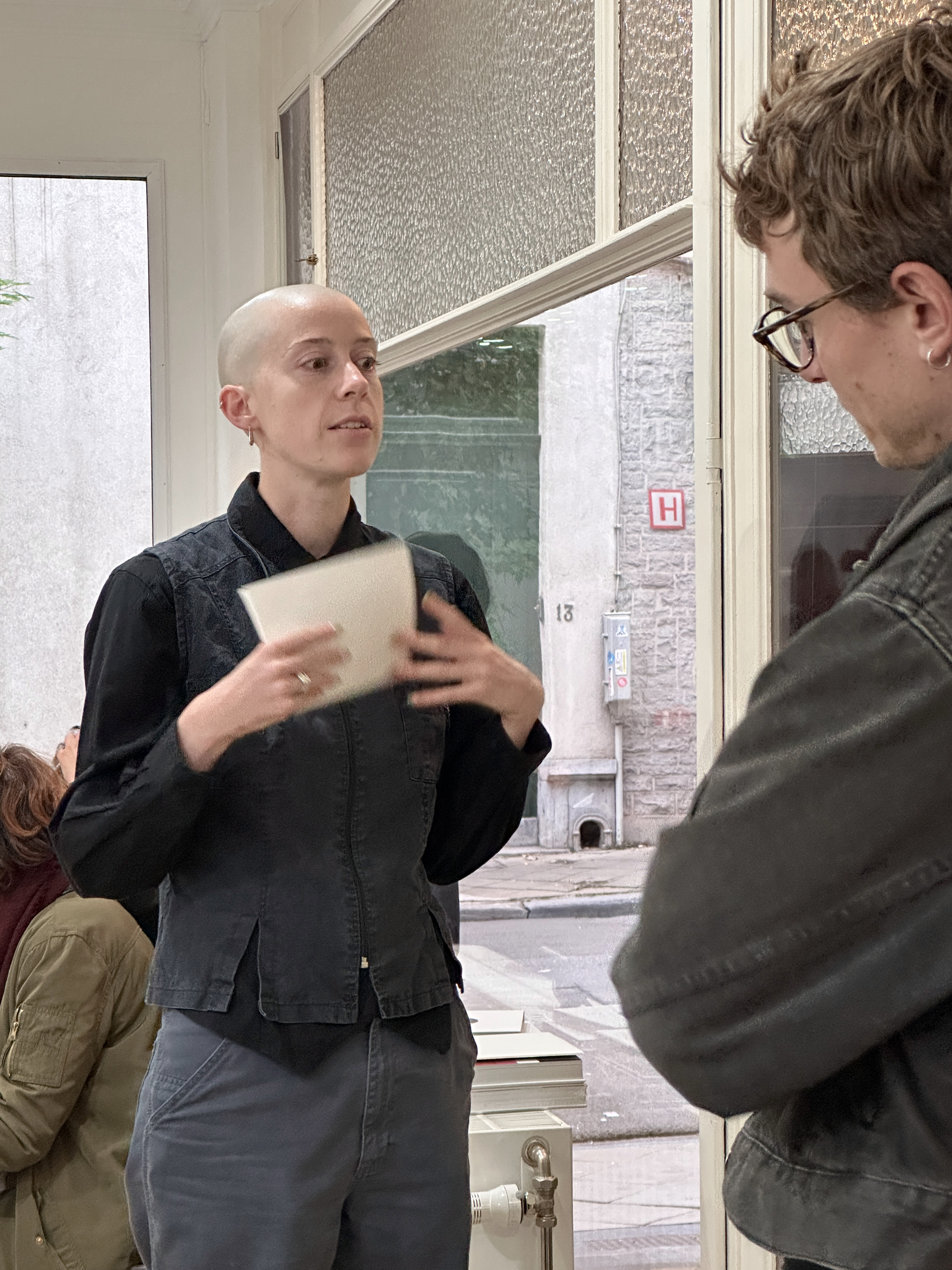
︎ ABOUT
STEVE VAN DEN BOSCH ( °1975, BE) lives and works in Brussels
Attracted to the seemingly inexpressive, the unintentional and the mute, he creates work that constantly oscillates between invisibility and materiality. Unbound by any specific medium, he questions the very conditions of the artwork by subverting its parameters, thereby disrupting established logics. His work has been exhibited internationally, including at Kunsthalle Bern, Witte de With (Rotterdam), the Shanghai and Sydney Biennials, and the Contemporary Art Museum in St. Louis.
MARC BEHRENS ( °1970, DE) lives and works in Offenbach am Main
His work spans electronic and concrete music, installations, photography, and video. Active since 1989, he has released over 40 albums and presented projects worldwide. Behrens often explores sound in remote locations, social structures, more recently he composed and produced Eure Welt – Ein Audiodrive with Hannes Seidl, a performance piece with cars and healing frequencies. He has performed across Europe, Asia, the Americas, Africa, and the Middle East.
︎ Open on Fri. and Sat. 14:00 - 18:00 and by appointment
︎ Exhibition open on Fri. 5 - Sat. 6 & Sun. 7.09.2025 14:00-18:00
and by appointment at info@sb34.org
︎ Finissage on Saturday 11.10.2025, 18:00-20:00
With a reading of a text by Alcija Melzacka, performed by Francesca Hawker
Documented by © Marc Behrens
Avec le soutien de la Fédération Wallonie-Bruxelles et de la COCOF.

